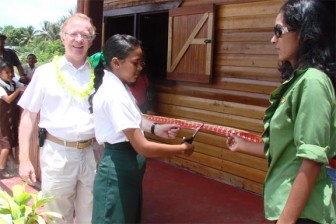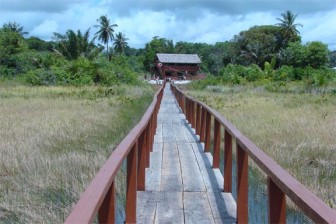Canadian High Commissioner David Devine on Tuesday commissioned a guest house and boardwalk at Lake Capoey Village, which are aimed at providing employment through the promotion of eco-tourism.
According to a press release from the High Com-mission of Canada, it partnered with the Capoey Village Council and the Guyana Environmental Capacity Development Project II (GENCAPD II) to build the inn and boardwalk. Canada, through the Canada Fund for Local Initiatives and GENCAPD II, provided $7.7M for the project.
Ambassador Devine and Toshao Valerie De Younge unveiled the guesthouse billboard in the presence of the regional chairman, village councillors, a representative of the Inter-American Institute for Cooperation in Agriculture (IICA), and residents at a brief opening ceremony held on Tuesday.

In his address, Devine noted the key role tourism is playing in the global economy and emphasised the importance of tourism to communities such as Lake Capoey Village. He also alluded to the 13th Annual Caribbean Tourism Association Carib-bean Conference on Sustain-able Tourism Development that opened here this week and said that he believed that the Guyana Government was committed to becoming a leader in the Caribbean in the advancement of the tourism sector.
The Ambassador encouraged the toshao and village council to be inspired by the beautiful landscape of the lake and to think about ways to attract visitors to use the guesthouse facilities.
“Perhaps you can take some photographs and post them on the internet, or you may wish to create a Facebook page. You may also work with the Ministry of Tourism to assist you in promoting and marketing Lake Capoey Village as an eco-tourism site. These are all options that I invite you to explore in order to promote this lovely Lake and village and all that it has to offer,” he said.
In her response, De Younge was high in praise of the Canadian government for its contribution to the project and she thanked the High Com-missioner for his support. She noted that within one month of applying for funding for the project to CIDA, she received a response and obtained the full support from the CIDA staff for the duration of the project. De Young noted that it was due to the hard work and effort of this team that the guesthouse and pier came to fruition.

“The objective of the project is to contribute to revenue generation for the village and provide employment for at least two village women, all resulting in improved welfare and sustained livelihood for the 411 residents of the agricultural based community, through the promotion of agro-tourism as well as eco-tourism,” the release said. The guesthouse and boardwalk were built using mainly indigenous materials and labour. It is 26 feet by 40 feet and comprises three guest rooms, each with a balcony overlooking Lake Capoey, a central living room and dining and kitchen area. The boardwalk pier is four feet wide, 840 feet long and it provides an easy, direct, safe and optional private access to the hostel. “This in itself is an added tourist attraction since it will be completed with a thatched roof, under which benches are to be installed,” the release added.
Maxine Parris, of the IICA, also contributed to the project by delivering technical advice on the design of the small hostel to promote a safe and hygienic environment for the handling and preparation of food. Crops grown by the community will be used to supply the guesthouse.





